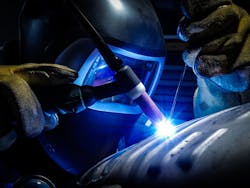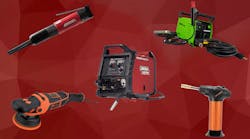The number of electric vehicles in global circulation has increased six-fold between 2013 and 2017 (last year of available data), according to the International Energy Agency (IEA). In the United States alone, approximately 760,000 electric vehicles (EVs) traverse roads and highways. One force behind steadily increasing EV sales is the improved performance of the batteries used in these vehicles. Primarily lithium-ion, these batteries must hold sufficient energy to propel vehicles at high speeds for hours on end. Designing lighter, smaller, safer, and more efficient batteries is proving to be instrumental in continuing global EV sales trends. Advancements in welding technologies increase efficiency for automotive powertrains by improving energy storage, cutting size, and preserving reliability.
Whether a driver intends to use an electric vehicle for a daily commute or only sporadically, he or she expects that the battery will hold a charge and not lose too much energy in use. In other words, manufacturers aim to design batteries with a greater range between charges and that, when they need to be charged, charge faster. A primary cause of battery energy loss is resistance. In a perfect world, there would be no resistance between battery and load, but the connection of a tab to a terminal implies a certain amount of loss. This, of course, can be mitigated by using more conductive materials. With the standard stainless-steel terminals of lithium-ion batteries, for example, this presents an engineering opportunity: to reduce resistance, weld the stainless steel to a dissimilar and less resistant, metal.
Challenges abound, however, when seeking to weld two different metals together. Different metals have different melting temperatures, different expansion coefficients, and sometimes incompatible chemistry. For example, aluminum melts at 1,220 degrees F — fully 1,512 degrees F lower than stainless steels’ 2,732 degrees F melting temperature. Welding these metals effectively is impossible with the contact process of resistance welding.
Fiber lasers weld dissimilar metals
Resistance welding has been a cornerstone technology for welding battery packs for many years. Typically, this technology has been used to join nickel tab material to steel battery cans. It has proven less successful for welding some other metals.
“Resistance welding does not work well with aluminum or copper because they are more conductive, so the weld head cannot create the requisite energy build-up,” explains Mark Boyle, product manager at Amada Miyachi America.
Thus, alternative technologies like laser welding need to be considered for joining conductive metals. Even with laser technology, however, bonding dissimilar metals is not straightforward. The melting points of different materials vary greatly (for example, aluminum melts at 1220 degrees F and copper at 1976 degrees F), and the metallurgy of these different materials form brittle intermetallic bonds when fusion welded together.
New laser sources provide the opportunity for such dissimilar metal joining, including CW and pulsed fiber lasers. A 500 W Single Mode Continuous Wave Fiber Laser Micro Welder from Amada Miyachi America, for example, concentrates the energy into a small spot to aid energy coupling into the material and resultant penetration. There is little change in penetration even with increasing scan speeds. The benefit of this is two-fold: faster processing and minimized heat input. A closer look at the process shows that it is not like traditional fusion welding at all as there is no large mixture of the two parts. For example, a resulting weld between aluminum and cold rolled steel has no cracks and minor porosity, an impossible result in classic welding techniques because the intermetallic mix of aluminum and steel is naturally brittle. This new technique shows promise for a variety of applications. In one case study, mechanical testing found peel strength to be good—after thermal soak and shock, fifty samples of the weld peeled within ±2 N. This narrow band of peel results shows reproducibility and reliability needed in production.
Amada Miyachi has also used a 70 W pulsed fiber laser to join thin dissimilar metals. These require more welds to create the same contact area in a weld zone and ensure appropriate weld strength at the material interface. (The pulsed laser delivers limited power and small spot size.) So, the system is programmed to deliver a spiral weld pattern which groups small spot welds in close proximity in a geometry that creates good weld strength.
“The [resulting] weld profile closely resembles multi-staking process,” reports Boyle, “and does not show the characteristic form of conventional pulsed spot welds.”
The cross-section of the weld shows that the intermetallic zone is less than ten microns in size. Even though the individual welds are small, the technique produces single-layer shear strengths of around 44 N and double-layer shear strengths of around 88 N. In addition to aluminum to steel, potential weld combinations include copper to steel, titanium to steel, copper to titanium, and copper to aluminum.
Creating efficiencies with fiber lasers
The ability to weld dissimilar metals creates a variety of efficiency advantages for electric vehicle batteries. Together, aluminum and copper, which are very conductive materials, provide ideal conditions to transfer the electrical current efficiently.
Of course, efficiency is important not only for the end-user but also on the production side. Developments in laser beam delivery combined with intelligent tooling have decreased process times.
As with any process, access to the weld area is key. Historically, this meant that the part was mounted on an XY stage and moved relative to a fixed laser beam.
In the last five to 10 years, however, Amada Miyachi America developed galvo scanning beam delivery as a quick and efficient way to guide the laser beam over the part. In a 2D galvo scan head, two mirrors are adjusted to steer the laser beam in an XY plane. Since this system only moves small, lightweight mirrors, as opposed to the entire part, the motion can be extremely fast—process speeds can reach up to 3 m/s. This can dramatically cut down process time.
A key challenge of this delivery system is properly tooling the parts so that each and every location of the weld is in intimate contact. “The fundamental tenet of welding is that you can’t weld air,” quips Boyle. As a secondary tooling concern, the laser beam must have access to the weld zone.
One solution to these challenges is simple — machine tapered holes to minimize openings but maximize laser access — but illustrates the type of tooling consideration required to integrate laser welding into a production process.
New laser technologies drive growth
Despite clear benefits, there are still challenges to using laser welding in electric vehicle battery production. Resistance welding monitors play an important role in both product development and quality control. The technology for similar devices to evaluate laser welds is still being researched.
“On the laser side, monitoring is in its infancy,” Boyle says. This developing technology, though, promises to push battery production efficiency for electric vehicles even further when it becomes available. Therefore, advanced laser welding technology seems poised to continue to drive electric vehicle efficiencies in both the short and long terms.
Information provided by Amada Miyachi America, Inc.


